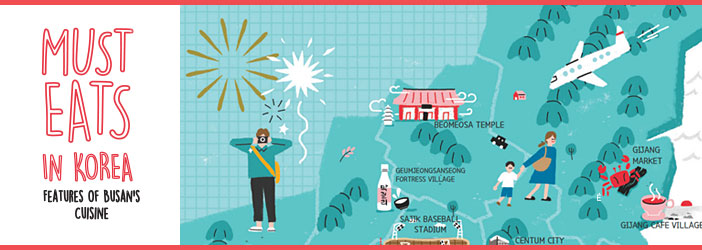-
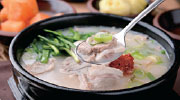
1 Pork and Rice Soup
Dwaejigukbap, or pork and rice soup, is made with sliced pork in a thick pork bone broth. It can be eaten by mixing cooked rice with the soup. This dish reportedly originated from the Korean War (1950-1953) when refugees made soup with pork bones and other ingredients that were easily available at the time. Depending on one's preference, the soup can be enjoyed with saeujeot (salted shrimp), buchumuchim (seasoned garlic chives), or kkakdugi (diced radish kimchi) added on top.
-
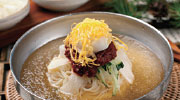
2 Wheat Noodles
Milmyeon, or wheat noodles, is said to be first developed by refugees who fled from North Korea during the Korean War. The dish was made with broth from beef, pork or chicken bones. The broth was then cooled and the chewy and soft wheat noodles were added. The dish is quite affordable. There are two kinds of milmyeon: mulmilmyeon — wheat noodles in a cold broth, and bibimmilmyeon — wheat noodles mixed with a spicy sauce.
-

3 Dongnae-style Green Onion Pancake
Dongnaepajeon, or Dongnae-style green onion pancake, is known to be a precious dish offered to the king during the Joseon Dynasty period (1392-1910). It is prepared with a rice flour batter that is mixed with fresh seafood, beef, water dropwort and chives. The batter is pan fried and a beaten egg is added to the top. The rich taste of the seafood pancake is enhanced when dipped with a vinegared red pepper paste.
-

4 Chilled Braised Pigs' Feet Salad
Naengchaejokbal, or chilled braised pigs’ feet salad, is a savory dish made of thinly sliced braised pigs’ feet, jellyfish, various vegetables and a spicy mustard sauce. The pigs’ feet are chewy and the taste blends well with the crispy vegetables and refreshing mustard sauce. Pigs’ feet, the main ingredient, are boiled and then braised with a soy sauce. Pigs' feet are rich in collagen, which is good for the skin and prevents aging.
-

5 Sliced Raw Fish
Busan is a port city that is abundant in seafood. Seaside restaurants and markets offer fresh raw fish at affordable prices. Saengseonhoe (or sliced raw fish) is prepared fresh upon order so it tastes sweet and chewy. In the Millak Hoe Center, located near Gwangalli Beach, there are restaurants where one can eat fresh sliced raw fish while enjoying the splendid views of Gwangandaegyo Bridge.
-

6 Puffer Fish Soup
Bokguk is a clean puffer fish soup made by boiling chopped pieces of puffer fish with soybean sprouts, white radish, water dropwort and garlic sauce. The soup delivers the clean and savory taste of puffer fish. In Busan, fresh puffer fish is easily available, and there are many restaurants that specialize in puffer fish dishes — as they have developed the required skills for removing poison from the fish.
-
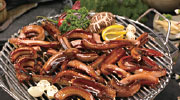
7 Grilled Eel
Gomjangeogui, or grilled eel, became popular after the Korean War when refugees ate grilled eel to appease their hunger. Slippery eels are caught, chopped and grilled on a griddle or over a straw fire. Grilled eels are chewy and tender, and depending on one's preference, enjoyed with just salt or a spicy sauce.
-
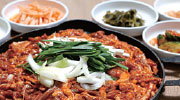
8 Duck Bulgogi
In Busan, there are several famous oribulgogi, or duck bulgogi, restaurants located at the foot of the mountains. Among them, the restaurants at Geumjeongsan Mountain are especially popular. Oribulgogi is made by grilling duck meat with a spicy seasoning and then topping it with garlic chives before serving. The great texture of duck meat is enhanced by the strong seasoning preferred by Busan locals.
-
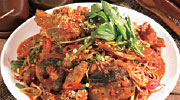
9 Braised Spicy Monkfish
Agwijjim, or braised spicy monkfish, is made by braising together fresh monkfish, other seafoods and soybean sprouts and then seasoned with red pepper powder. Unlike the agwijjim dish of the Masan area, which uses dried monkfish, the agwijjim dish of Busan is made by boiling fresh raw monkfish and seafood. It thus offers a clean, distinctive flavor that cannot be found elsewhere.
-
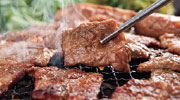
10 Grilled Spareribs
Cheolma Beef is a famous premium beef brand in Busan, that sells only the highest-grade beef from cows or heifers. That is why galbi (grilled sparerib) dishes made with cow or heifer meat are popular in Busan. One of Korea’s top five galbi restaurants is in Busan. In Choryangdong, Busan, there is a dwaejigalbi (grilled pork rib) street developed since 1950, where one can enjoy grilled pork ribs characterized by sweet soy sauce seasoning and smoky flavors.
-
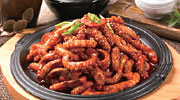
11 Spicy Stir-fried Octopus
Busan-style nakjibokkeum, or stir-fried octopus, is called jobang nakjibokkeum. It is said that in the 1960s, a restaurant located in front of Joseon Textile Company started to serve the dish to workers. Unlike other nakjibokkeum recipes that use red pepper paste which makes the sauce rather thick, jobang nakjibokkeum is made by using red pepper powder and a seafood broth to offer the natural clean taste of the octopus.
-

12 Busan-style Fish Cake & Fried Bean Curd Hot Pot
Traditional markets in Busan offer many delicacies that attract locals and visitors alike. Especially popular are eomuk (fish cake) and yubujeongol (fried bean curd hot pot). Busan-style fish cake contains large amounts of fish, so the fish cakes are more chewy and savory. Yubujeongol is a hot pot dish made by boiling pocket-shaped fried bean curd pieces, filled with glass noodles and vegetables, with Busan-style fish cake in a broth. The hot pot offers a deep rich flavor that comes from the fried tofu, fish cake and anchovy stock.
-

13 Black Goat Bulgogi
Heugyeomsobulgogi is black goat bulgogi, which is made by grilling seasoned black goat meat. In Busan, the dish uses meat from black goats grazed in Geumjeongsanseong Village making it especially popular. Only female black goat meat is used, which offers a soft texture and less of a gamey flavor. The meat is covered with a red pepper paste seasoning and then grilled over a charcoal fire. The sweet and spicy seasoning is well blended with the smoky flavor
-

14 Spicy Seafood Stew
Haemultang is a spicy seafood stew made with fresh seafood such as fish, crustaceans, and shellfish. In the port city of Busan, haemultang naturally became a popular dish, as various kinds of seafood are easily available. The seafood stew offers a spicy and savory flavor with its red pepper paste seasoning, herbs and seafood stock.
-
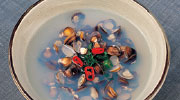
15 Marsh Clam Soup
Jaecheopguk is a clean soup made with boiled flesh of marsh clams seasoned with salt before serving. Samnak-dong in Sasang-gu, Busan, located near the Nakdonggang Estuary, was once famous for marsh clam cultivation. Jaecheopguk, which is rich in protein and minerals, is popular for its clean savory soup, and is often eaten to relieve hangovers.
-
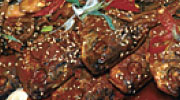
16 Braised Crucian Carp
Bungeojjim is a braised crusian carp made by boiling crusian carp with vegetables and a fermented seasoning. The seasoning uses over 20 ingredients so that the fishy taste is removed. Traditional recipes call for the crusian carp to be braised in a wooden steamer so it offers a chewy and savory taste. Located along the Nakdonggang Estuary in Busan, there are many reservoirs and bungeojjim has long been enjoyed by the locals.

















